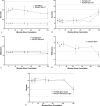Coagulopathy Characterized by Rotational Thromboelastometry in a Porcine Pediatric ECMO Model
- PMID: 32981958
- PMCID: PMC7499218
- DOI: 10.1182/ject-2000011
Coagulopathy Characterized by Rotational Thromboelastometry in a Porcine Pediatric ECMO Model
Abstract
Venoarterial extracorporeal membrane oxygenation (VA-ECMO) is used to support patients with reversible cardiopulmonary insufficiency. Although it is a lifesaving technology, bleeding, inflammation, and thrombosis are well-described complications of ECMO. Adult porcine models of ECMO have been used to recapitulate the physiology and hemostatic consequences of ECMO cannulation in adults. However, these models lack the unique physiology and persistence of fetal forms of coagulation factors and fibrinogen as in human infants. We aimed to describe physiologic and coagulation parameters of piglets cannulated and supported with VA-ECMO. Four healthy piglets (5.7-6.4 kg) were cannulated via jugular vein and carotid artery by cutdown and supported for a maximum of 20 hours. Heparin was used with a goal activated clotting time of 180-220 seconds. Arterial blood gas (ABG) was performed hourly, and blood was transfused from an adult donor to maintain hematocrit (Hct) > 24%. Rotational thromboelastometry (ROTEM) was performed at seven time points. All animals achieved adequate flow with a patent circuit throughout the run (pre- and post-oxygenator pressure gradient <10 mmHg). There was slow but significant hemorrhage at cannulation, arterial line, and bladder catheter sites. All animals required the maximum blood transfusion volume available. All animals became anemic after exhaustion of blood for transfusion. ABG showed progressively declining Hct and adequate oxygenation. ROTEM demonstrated decreasing fibrin-only ROTEM (FIBTEM) clot firmness. Histology was overall unremarkable. Pediatric swine are an important model for the study of pediatric ECMO. We have demonstrated the feasibility of such a model while providing descriptions of physiologic, hematologic, and coagulation parameters throughout. Weak whole-blood clot firmness by ROTEM suggested defects in fibrinogen, and there was a clinical bleeding tendency in all animals studied. This model serves as an important means to study the complex derangements in hemostasis during ECMO.
Keywords: ECMO; animal model; coagulopathy; transfusion.
© Copyright 2020 AMSECT.
Figures





References
-
- Gerweck LE, Seetharaman K. Cellular pH gradient in tumor versus normal tissue: Potential exploitation for the treatment of cancer. Cancer Res. 1996;56:1194–8. - PubMed
-
- Bartlett RH, Roloff DW, Cornell RG, et al. . Extracorporeal circulation in neonatal respiratory failure: A prospective randomized study. Pediatrics. 1985;76:479–87. - PubMed
-
- O’Rourke PP, Crone RK, Vacanti JP, et al. . Extracorporeal membrane oxygenation and conventional medical therapy in neonates with persistent pulmonary hypertension of the newborn: A prospective randomized study. Pediatrics. 1989;84:957–63. - PubMed
MeSH terms
LinkOut - more resources
Full Text Sources
